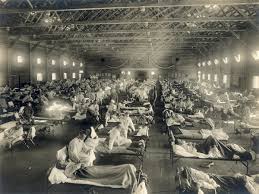MARCH 25, 2020 – Lately I’ve pondered what my grandparents would’ve said about the current crisis. They were born in the early 1890s and lived to advanced ages, topped by my maternal grandmother, who died at 100. They lived through many cataclysms, but as far as I could tell, were none the worse for wear.
Well, that’s me talking—and mostly from the perspective of comparative youth. They appeared “none the worse for wear” because, well, they’d survived. And despite having been in the American Expeditionary Force in France during the Great War, my grandfather Nilsson survived with sight, hearing, psyche, and all four limbs intact. But in retrospect, I realize that what I perceived as “unscathed” was the general stoicism that characterized that generation.
Well, okay, my maternal grandmother—the one who lived to be 100—had come from a family of above-average means, and based on the photo albums that survived an enormous house fire several years after she’d died, she led an easy life in notable style. And my paternal grandmother, an immigrant from agrarian Sweden, landed well as a domestic in the household of the local aristocracy, as it were, of Minneapolis. Frugal to her dying day, she nevertheless dressed to the nines, thanks to her natural refinement and practical skill in making her own clothes (with the exception of her fur stoles purchased on sale at the famous department store owned by her former employer).
But however comfortable these “people of mine” appeared to me in my comfort, they had lived through the Great War, the Great Depression, World War II, the Korean War, threat of thermo-nuclear war, the Cold War, and . . . the one horrific episode that received no mention that any of my sisters or I can remember—the 1918 flu pandemic.
Our grandparents were then, as my sisters and I are now: members of the most vulnerable demographic; for today, as people over 60, we are at “higher risk” of complications from the Corvid-19, whereas back in 1918, young adults—our grandparents—were the most at-risk.
Yet, we heard nothing of the disease that wiped out many millions and disrupted the lives of many millions more. The fatality rate in the U.S. alone reduced the life expectancy here by a dozen years. As measured by absolute numbers and percentages, the 1918 pandemic was far worse than the worst-case projections concerning Corvid-19. Surely our grandparents—city dwellers—had to have worried; surely friends of theirs succumbed. I think especially of Grandpa Nilsson, always in close quarters with other soldiers (except when his captain got him gigs playing violin for “the brass” holed up in local chateaux) and never able to maintain “social distancing.” Grandpa told much about the Great War but said nothing about the contagion that killed more American soldiers than battles had.
Then again, our grandparents didn’t have cable news or social media to fan their fears. And they survived to live, not to wallow in troubled memories. In that regard, they truly became, “none the worse for wear.”
(Remember to subscribe to this blog and receive notifications of new posts by email.)
© 2020 by Eric Nilsson
